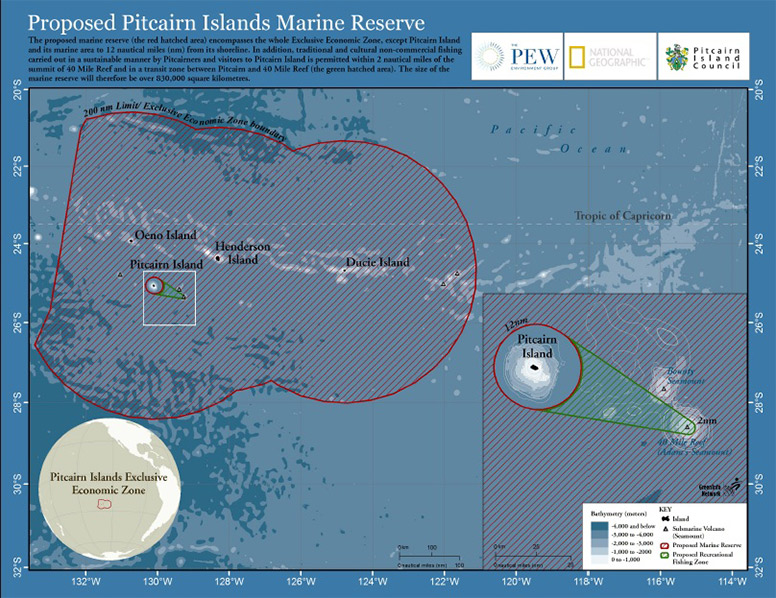Proposal for the Establishment of a Pitcairn Islands Marine Reserve

In this map, the red hatched area represents the proposed marine reserve and the green hatched area represents the area where non-commercial sustainable fishing would be permitted.
The purpose of the Pitcairn Islands Marine Reserve is to fully protect the special marine environment and to provide a world-class, fully protected marine reserve to attract scientific research, non-consumptive tourism and other non-extractive economic uses, and favourable global recognition for Pitcairn.
We propose the establishment of a Pitcairn Islands Marine Reserve with the following provisions:
- The marine reserve will comprise the waters of the Pitcairn Island complex starting 12 nautical miles from mean low-water off the coast of Pitcairn Island and extending out to the limit of the exclusive economic zone and including all of the waters of Oeno, Henderson, and Ducie islands.
The zone between Pitcairn Island's mean low-water and extending to 12 nautical miles offshore will be excluded from the marine reserve which will allow Pitcairners and visitors, as permitted by regulation, to continue to use the area around the island for fishing and other activities as they do now. The marine reserve would include the area beginning 12 nautical miles from Pitcairn out to the 200 nautical mile limit. At over 830,000 square kilometres, this would create the world's largest marine reserve and attract considerable worldwide attention. Pitcairn, home of the HMAV Bounty, could also become the world's largest highly protected marine reserve. - All fishing and the extraction of other natural resources shall be prohibited in the marine reserve save for:
- Fishing that is carried out by Pitcairners for subsistence or cultural purposes during visits to other islands located within the marine reserve, for consumption during that visit.
- Traditional and cultural non-commercial fishing carried out in a sustainable manner by Pitcairners and visitors to Pitcairn Island within 2 nautical miles of the summit of 40 Mile Reef (also called Adams Seamount), and in a transit zone between Pitcairn and 40 Mile Reef.
- Any vessels entering or passing through Pitcairn's EEZ, are:
- Prohibited from discharging ballast water or pollutants.
- Required to anchor at designated sites only.
- Required to report sightings of vessels fishing illegally in Pitcairn's EEZ to the Natural Resources Department on Pitcairn Island.
- Required to observe due care to avoid the introduction of any alien species into the water or on to land, and to observe all biosecurity regulations as may be established under Pitcairn law.
- The management and operation of the marine reserve will be subject to review every 10 years.











